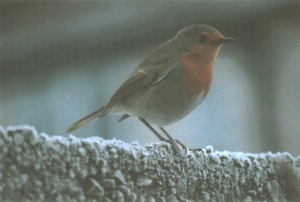நிற மேலாண்மை ஏன் முக்கியம்?
நிற மேலாண்மை என்பது ஒரு உள்ளீட்டு சாதனத்தைப் பயன்படுத்தி ஒரு நிறத்தைப் பதிவு செய்து, அதை ஒரு திரையில் காட்சிப்படுத்தி, பிறகு ஒவ்வொரு ஊடகத்திலும் துல்லியமான நிறங்களும் நிற வரம்புகளும் குலையாதபடி அவற்றை அச்சிடும் செயலே ஆகும்.
குளிர் காலத்தில் பனிமூட்டம் நிறைந்த ஒரு நாளில் ஒரு பறவையைப் புகைப்படமெடுத்துப் பார்த்தால், நிற மேலாண்மையின் அவசியம் தெளிவாக விளங்கும்.
டிஸ்ப்ளே சாதனங்கள் வழக்கமாக நீல சேனலை அதிக பூரிதப்படுத்தி படங்கள் குளிர்ச்சியாகக் காட்சியளிக்கும்படி செய்கின்றன.
Notice how the white is not “paper white” and the black of the eye is now a muddy brown.
ஒவ்வொரு சாதனமும் கையாள முடிகின்ற நிறங்களின் வரம்பு வெவ்வேறானதாக உள்ளது என்பதே இதில் உள்ள அடிப்படை சிக்கலாகும். ஆகவே எலக்ட்ரிக் நீல நிறமுள்ள ஒரு புகைப்படத்தை நீங்கள் படம்பிடிக்க முடியும், ஆனால் அதை பெரும்பாலான அச்சு சாதனங்கள் துல்லியமாக மறு உருவாக்கம் செய்ய முடியாது.
Most image devices capture in RGB (Red, Green, Blue) and have to convert to CMYK (Cyan, Magenta, Yellow, and Black) to print. Another problem is that you can’t have white ink, and so the whiteness can only be as good as the paper color.
Another problem is units. Without specifying the scale on which a color is measured, we don’t know if 100% red is near infrared or just the deepest red ink in the printer. What is 50% red on one display is probably something like 62% on another display. It’s like telling a person that you’ve just driven 7 units of distance, without the unit you don’t know if that’s 7 kilometers or 7 meters.
In color, we refer to the units as gamut. Gamut is essentially the range of colors that can be reproduced. A device like a DSLR camera might have a very large gamut, being able to capture all the colors in a sunset, but a projector has a very small gamut and all the colors are going to look “washed out”.
In some cases we can correct the device output by altering the data we send to it, but in other cases where that’s not possible (you can’t print electric blue) we need to show the user what the result is going to look like.
For photographs it makes sense to use the full tonal range of a color device, to be able to make smooth changes in color. For other graphics, you might want to match the color exactly, which is important if you’re trying to print a custom mug with the Red Hat logo that has to be the exact Red Hat Red.


